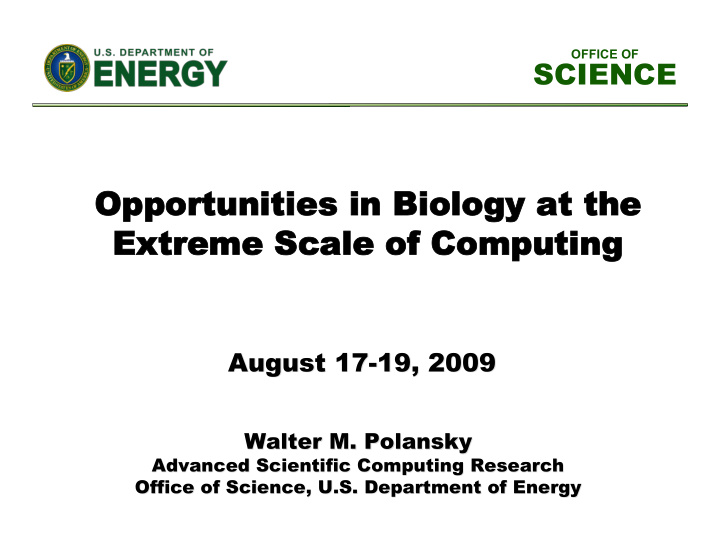



OFFICE OF SCIENCE Opportunities in Biology at the Opportunities in Biology at the Extreme Scale of Computing Extreme Scale of Computing August 17-19, 2009 August 17-19, 2009 Walter M. Polansky Walter M. Polansky Advanced Scientific Computing Research Advanced Scientific Computing Research Office of Science, U.S. Department of Energy Office of Science, U.S. Department of Energy
Vision Vision -- Advanced Scientific Computing Research -- -- Advanced Scientific Computing Research -- Deliver Petascale Science Today – Continue to make the Leadership Computing Facilities available to the very best science through Innovative and Novel Computational Impact on Theory and Experiment (INCITE). – Continue to work with Pioneer Applications to deliver scientific results from day one. Build the Intellectual Foundation for the Future – Continue to nurture – • World class mathematics and computer science research efforts • Applications critical to DOE missions through Scientific Discovery through Advanced Computing (SciDAC). – Provide direct support for “bleeding-edge” research groups willing to take on the risk of working with emerging languages and operating systems. – Foster innovative research at the ever blurring boundary between Applied Mathematics and Computer Science. Realize the Promise of Extreme Scale – Work with key science applications to identify opportunities for new research areas only possible through extreme scale computing. – Support innovative research on advanced architectures and algorithms that accelerates the development of hardware and software that is well suited to extreme scale computational science. 2
ASCR Research ASCR Research Provide forefront research knowledge and foundational tools: – Continuing excellence in applied mathematics, computer science and next generation networking research – Advancing scientific discovery through cross- disciplinary partnerships (SciDAC) 3
Leadership Leadership Applied Mathematics and Computer Science Software Developed under ASCR Funding Programming Development/ Models Performance Tools Math Libraries System Software Active Harmony BABEL ACTS COLLECTION Cluster Command & Control Berkeley Lab Checkpoint Restart High-Availability OSCAR HA - ARMCI (BLCR) ADIC OSCAR ATLAS Dyninst API Hypre LWK-Sandia Berkeley UPC Compiler Fast Bit ITAPS Software Suite PVFS Charm++ Goanna LAPACK ZeptoOS Fountain HPCtoolkit Mesquite Collaboration FT -MPI Jumpshot MPICH2 Global Arrays KOJAK OpenAD enote Kepler MPIP OPT++ MVAPICH MRNet PETSc OPEN-MPI Net PIPE ROMIO Visualization /Data OpenUH OpenAnalysis ScaLAPACK Analytics PVM PAPI Sparskit -CCA ROSE Trilinos BeSTMan ScalaTrace Parallel netCDF STAT Virtual Data Tool Kit TAO Miscellaneo us TAU Hpcviewer Libmonitor 4
Scientific Discovery through Scientific Discovery through Advanced Computing (SciDAC) Advanced Computing (SciDAC) Advancing Science through large- scale data, modeling and simulation – Science Application and Science Applications Partnerships: Astrophysics, Accelerator Science, Climate, Biology, Fusion, Petabyte data, Materials & Chemistry, Nuclear physics, High Energy physics, QCD, Turbulence, Groundwater – Centers for Enabling Technology: Address mathematical and computing systems software issues – Institutes: Assist Scientific Applications teams and foster next generation computational scientists http://www.scidac.gov 5
ASCR Facilities ASCR Facilities Providing the Facility – High-End and Leadership Computing Investing in the Future - Research and Evaluation Prototypes Linking it all together – Energy Sciences Network (ESnet) 6
Innovative and Novel Computational Innovative and Novel Computational Impact on Theory and Experiment Impact on Theory and Experiment Innovative and Novel Computational Impact on Theory and Experiment (INCITE) program started in 2004. – Small number of computationally intense, high impact projects – Open to all national and international researchers, including industry – No requirement of DOE or Office of Science funding or topic area – Peer and computational reviews 2009 INCITE projects Approximately 890 million processor hours awarded in 2009 Approximately 1.3 Billion processor hours available in 2010 7
Realizing the promise of Extreme Scale Realizing the promise of Extreme Scale Listening to the Community Listening to the Community Three Town Hall Meetings held April-June, 2007 Climate, Combustion, Fusion, Fission Solar, Biology, Socioeconomic Modeling and Astrophysics Mathematics, Computer Science Algorithms, Software infrastructure and Cyberinfrastructure Integrated program- investments in hardware, algorithms and scientific software research and development Tightly coupled to a selected set of scientific communities and the associated applied mathematics research. 8
Science Needs at the Extreme Scale Science Needs at the Extreme Scale Workshop calendar Workshop calendar Prior – BER/Climate Workshop: Challenges in Climate Change Science and the Role of Computing at the Extreme Scale, November 6-7, 2008 – HEP/High Energy Physics Workshop: Scientific Challenges for Understanding the Quantum Universe and the Role of Computing at the Extreme Scale, December 9-11, 2008 – NP/Nuclear Physics Workshop: Forefront Questions in Nuclear Science and the Role of High Performance Computing – FES/Fusion Workshop: Extreme Scale Computing Challenges in Fusion Science, March 2009 – NE/Nuclear Energy Workshop: Science-based Nuclear Energy Systems Enabled by Advanced Modeling and Simulation at the Extreme Scale, May 11-12, 2009 – BES/Materials&Chemistry Workshop: Discovery in Basic Energy Sciences: The Role of Computing at the Extreme Scale, August 13-15, 2009 in Bethesda, MD Now – BER/Biology Workshop: Opportunities in Biology at the Extreme Scale of Computing, August 1 7-19, 2009 in Chicago Planned – NNSA/ASCR Workshop: Science Grand Challenges, October 6-8, 2009, in Washington, DC 9
Next Steps Next Steps ASCR will hold several cross-cutting workshops next FY as part of the process. ASCR will use the output from these workshops to prioritize funding opportunities all relevant areas: – Applied math and numerical algorithms, – Computer science including system software and tools, advanced computing architectures – Expanded partnerships • Pioneer/risk taking applications • New mission areas – Next generation networks – High Performance and Leadership Facilities 10
What computing is needed to enable the grand What computing is needed to enable the grand challenges in the the Biological Sciences ? Biological Sciences ? challenges in Exascale Exascale SciDAC X SciDAC X Petascale Petascale Core Research SciDAC 2 SciDAC 2 Terascale Terascale SciDAC 1 SciDAC 1 Perhaps the most significant applications of scientific computing come not in the solution of old problems, but in the discovery of new phenomena through numerical experimentation, Lax Report on Large Scale Computing in Science and Engineering, 1982 11
Recommend
More recommend